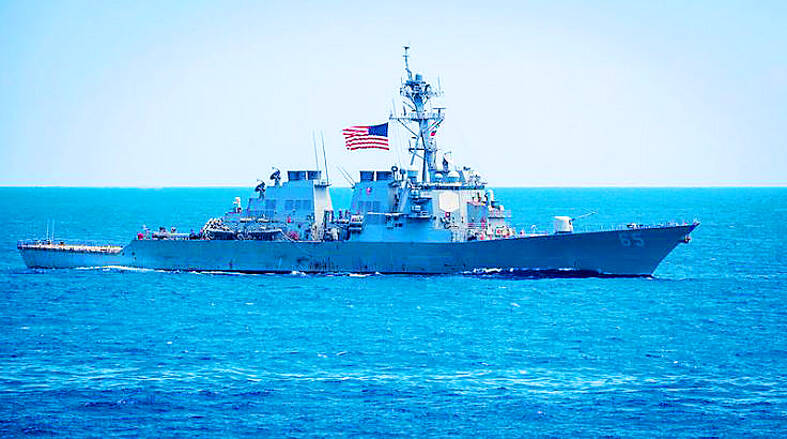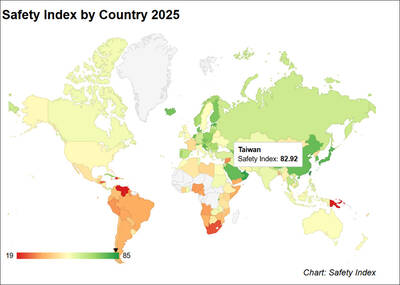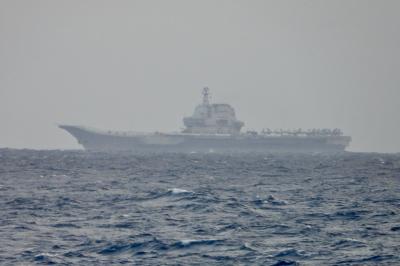More than half of Americans believe that the US should defend Taiwan in the event of a Chinese invasion, a survey commissioned by Newsweek found.
Of the respondents, 31 percent said they would approve and 25 percent said they would strongly approve of the US’ involvement in a cross-strait crisis, Newsweek reported on Friday.
The percentage increased to 56 percent from 47 percent in the middle of August last year, it said, adding that those who were against the US intervening remained the same at 12 percent.

Photo: Reuters
Half of the respondents believed the US was “committed by treaty” to defend Taiwan from a Chinese invasion, Newsweek reported.
The treaty refers to the US’ Taiwan Relations Act.
The survey collected 1,500 valid responses from eligible voters, and was conducted on April 4, the day before President Tsai Ing-wen (蔡英文) met with US House of Representatives Speaker Kevin McCarthy in California, Newsweek said.
The poll reflected that Taiwan was more frequently mentioned by political leaders in the US, said political scientist Raymond Kuo (郭泓均), director of RAND Corp’s Hu Taiwan Policy Initiative.
“There’s always been a latent amount of public support for Taiwan,” Newsweek quoted Kuo as saying.
Americans, regardless of political affiliation, are becoming more familiar with and concerned about Taiwan issues, he added.
However, one-third of the respondents said that they did not know whether Taiwan was a military ally of the US, indicating that “the semantic subtleties of US policy towards Taiwan are often lost,” Newsweek said.
Kharis Templeman, a research fellow at Stanford University’s Hoover Institution and program manager of the Hoover Project on Taiwan in the Indo-Pacific Region, was quoted as saying that the US should articulate its position on Taiwan.
Washington “views Taiwan’s international status as undecided, and that a final determination requires a peaceful and voluntary agreement from both sides of the strait,” Templeman said.
Although the US has made no official commitment to defend Taiwan, it has “a long-standing interest in seeing a peaceful resolution of differences across the strait,” he said.
Americans tend to take an unfavorable view of China and distrust Chinese President Xi Jinping (習近平), a sentiment that has grown in recent years, Newsweek said.
Forty-one percent of the poll’s respondents said China was “the greatest threat” to US interests, followed by Russia with 35 percent, North Korea with 7 percent and Iran with 3 percent, it said.
In other news, experts on Taiwan-US relations said in a new book published on Saturday titled US-Taiwan Relations: Will China’s Challenge Lead to a Crisis? that a cross-strait conflict is not inevitable.
Authors of the book include Ryan Hass, a senior fellow at the Brookings Institution, Bonnie Glaser, managing director of the German Marshall Fund of the US’ Indo-Pacific program, and former American Institute in Taiwan chairman Richard Bush.
The book discusses the US’ most effective responses to tackle China’s growing military threats against Taiwan, Amazon.com says.
The authors say that the US’ Taiwan policies should focus on understanding the hopes and fears of Taiwanese regarding the threats posed by China.
Maintaining a credible military deterrence is the minimum threshold, they said, adding that the US should fortify Taiwan’s economic dynamism, political autonomy, military preparedness, and dignity and respect on the world stage.

AIR SUPPORT: The Ministry of National Defense thanked the US for the delivery, adding that it was an indicator of the White House’s commitment to the Taiwan Relations Act Deputy Minister of National Defense Po Horng-huei (柏鴻輝) and Representative to the US Alexander Yui on Friday attended a delivery ceremony for the first of Taiwan’s long-awaited 66 F-16C/D Block 70 jets at a Lockheed Martin Corp factory in Greenville, South Carolina. “We are so proud to be the global home of the F-16 and to support Taiwan’s air defense capabilities,” US Representative William Timmons wrote on X, alongside a photograph of Taiwanese and US officials at the event. The F-16C/D Block 70 jets Taiwan ordered have the same capabilities as aircraft that had been upgraded to F-16Vs. The batch of Lockheed Martin

GRIDLOCK: The National Fire Agency’s Special Search and Rescue team is on standby to travel to the countries to help out with the rescue effort A powerful earthquake rocked Myanmar and neighboring Thailand yesterday, killing at least three people in Bangkok and burying dozens when a high-rise building under construction collapsed. Footage shared on social media from Myanmar’s second-largest city showed widespread destruction, raising fears that many were trapped under the rubble or killed. The magnitude 7.7 earthquake, with an epicenter near Mandalay in Myanmar, struck at midday and was followed by a strong magnitude 6.4 aftershock. The extent of death, injury and destruction — especially in Myanmar, which is embroiled in a civil war and where information is tightly controlled at the best of times —

Taiwan was ranked the fourth-safest country in the world with a score of 82.9, trailing only Andorra, the United Arab Emirates and Qatar in Numbeo’s Safety Index by Country report. Taiwan’s score improved by 0.1 points compared with last year’s mid-year report, which had Taiwan fourth with a score of 82.8. However, both scores were lower than in last year’s first review, when Taiwan scored 83.3, and are a long way from when Taiwan was named the second-safest country in the world in 2021, scoring 84.8. Taiwan ranked higher than Singapore in ninth with a score of 77.4 and Japan in 10th with

China's military today said it began joint army, navy and rocket force exercises around Taiwan to "serve as a stern warning and powerful deterrent against Taiwanese independence," calling President William Lai (賴清德) a "parasite." The exercises come after Lai called Beijing a "foreign hostile force" last month. More than 10 Chinese military ships approached close to Taiwan's 24 nautical mile (44.4km) contiguous zone this morning and Taiwan sent its own warships to respond, two senior Taiwanese officials said. Taiwan has not yet detected any live fire by the Chinese military so far, one of the officials said. The drills took place after US Secretary